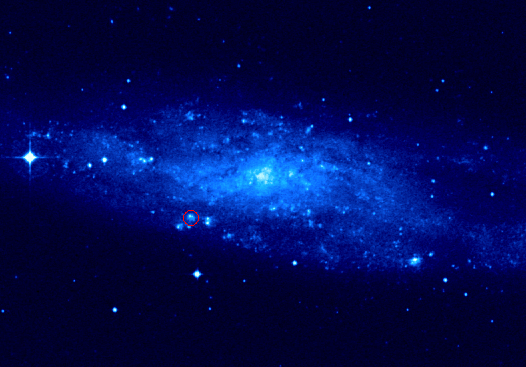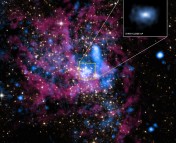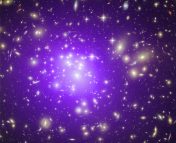Title: Chandra and HST Observations of the Supersoft ULX in NGC 247: Candidate for Standard Disk Emission
Authors: Lian Tao, Hua Feng, Philip Kaaret, Fabien Grisé, Jing Jin
First Author’s Institution: Tsinghua University, Beijing
Introduction: Accretion disks and X-ray sources

NASA illustration of an accretion disk. A black hole is pictured sucking in matter from its larger stellar companion, forming an accretion disk.
When it comes to the brightest sources of X-rays, the objects we observe usually fall into two camps: Active galactic nuclei (AGN) which result from the super-massive black holes in the centers of galaxies, and much-smaller X-ray binaries, which may be normal-sized black holes, white dwarfs, neutron stars or other compact objects with companion stars. In both cases, X-rays are produced when matter is sucked into a powerful gravitational well, spinning faster and faster like water going down a drain, forming a white-hot accretion disk which radiates an incredible amount of energy.
There is a theoretical limit to how bright an accretion disk can become, called the Eddington limit. In the Eddington limit, the pressure exerted by radiation which pushes the disk apart is perfectly balanced by the gravity of the accretor (the black hole, neutron star, etc.) which pulls it together. The Eddington limit is a limit on the intensity of the radiation: if the accretion disk was brighter than this limit, its radiation pressure would be so great that it would blow all the accreting matter away in very short time, and in short time there would be no X-ray source to observe. The Eddington limit depends upon the mass of the accreting object: a more massive object can hold together a brighter accretion disk.
We expect that ordinary black holes formed from the collapse of stars should typically be within three to thirty times the mass of the sun, whereas the super-massive black holes in the centers of galaxies are a hundred thousand or even a million times the mass of the sun. Therefore, the X-ray sources that we see should either be no brighter than the Eddington limit for a thirty-solar-mass black hole, or they should be active galactic nuclei: a pretty clear distinction, since the typical AGN’s luminosity is many orders of magnitude (~10,000 times) brigher than any binary.
This is indeed mostly what we see with X-ray telescopes like Chandra or XMM-Newton. However, astronomers have slowly uncovered a group of objects (called ultra-luminous X-ray sources, or ULXs) that don’t fit the bill: they’re too bright to be ordinary black holes, but too dim to be active galactic nuclei (they also don’t live in the centers of galaxies like AGN). Could they be the result of accretion around black holes which are somehow more massive than ordinary stellar black holes, or something else? The paper we’re looking at today hopes to answer this question for one ULX in particular.

An X-ray (Chandra) image of the galaxy NGC 247, with a circle showing the location of the ultra-luminous X-ray source.
The ULX in question
The authors chose to look at a ULX in the nearby galaxy NGC 247, using data from the Chandra and Hubble space telescopes. The galaxy is close enough that if there’s an accretion disk around the ULX, it should be visible in the Hubble data. The idea here is to identify the ULX’s optical counterpart: that is, does the object seen in the X-ray data have a counterpart in the optical (visible light) data?
The authors describe the careful alignment of their X-ray and optical images. The ULX does indeed have an optical counterpart in the Hubble data, and they proceed to measure its brightness.
The rest of the paper deals with the question of what this optical counterpart is. Partly, this is done by seeing how well the optical and X-ray brightnesses match up to various models. The authors find that if this wasn’t a normal accretion disk, then you wouldn’t expect the optical counterpart to be as bright as it is.
On the other hand, a model assuming that both the X-ray and visible light are being produced by the same, glowing-hot accretion disk is a much better fit. To be this bright while staying within the Eddington limit would require an intermediate-mass black hole of roughly a thousand times the mass of the sun.
There is some difficulty in fitting these models, because you can’t tell from these pictures whether the ULX is in front of or behind the main disk of NGC 247: if it’s behind the disk, then more of the visible light is being absorbed by dust in the galaxy and the optical counterpart is actually brighter than it appears.
The authors suggest that this ULX fits the picture of an accreting intermediate-mass black hole. The origin and nature of ULXs are still unknown, but studies such as this one contribute to our one day answering these questions.





Ryan I have a theory which may lead you to a logical explanation for the cause of ultra-luminous x-ray sources.
My theory is one without mathematical equations. It is simply a concept.
If you are interested please email me at [email protected]
(BTW: I love the teeny tiny smiley face in the blue frame at the bottom of the page!)